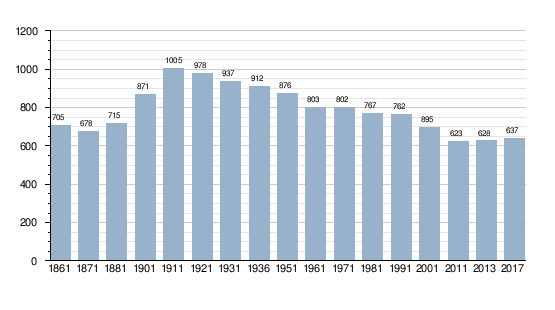Griante
| Griante | ||
|---|---|---|

|
|
|
| Country | Italy | |
| region | Lombardy | |
| province | Como (CO) | |
| Coordinates | 46 ° 0 ′ N , 9 ° 14 ′ E | |
| height | 250 m slm | |
| surface | 13 km² | |
| Residents | 620 (Dec. 31, 2019) | |
| Population density | 48 inhabitants / km² | |
| Post Code | 22011 | |
| prefix | 0344 | |
| ISTAT number | 013113 | |
| Popular name | griantesi | |
| Patron saint | SS. Nabore e Felice ( July 12th ) | |
| Website | Griante | |
Griante is an Italian commune in the province of Como , Lombardy region . It belongs to the Comunità Montana del Lario Intelvese . The tourist center on the lake, the Cadenabbia district, belongs to the municipality .
geography
Griante is located on the west bank of Lake Como, around 25 kilometers northeast of Como , between Menaggio (in the north) and Tremezzo .
The neighboring municipalities are: Menaggio , Tremezzina and on the opposite side of the lake Varenna ( LC ) and Bellagio .
Demographic development
Data from ISTAT
| Population development | |||||||||||||||
|---|---|---|---|---|---|---|---|---|---|---|---|---|---|---|---|
| year | 1861 | 1871 | 1881 | 1901 | 1911 | 1921 | 1931 | 1936 | 1951 | 1961 | 1971 | 1981 | 1991 | 2013 | 2017 |
| Residents | 705 | 678 | 715 | 871 | 1005 | 978 | 937 | 912 | 876 | 803 | 802 | 767 | 762 | 695 | 637 |

history
The name Griante is said to come from the Celtic Griant-tir (land of the sun), which means that it was founded in 500 BC. Could indicate. Gold coins and other devices indicate Roman residents. The settlement was first mentioned in documents in 383, when the Bishop of Como entrusted him with relics of Saints Nabor and Felix, which he is said to have received from Saint Ambrose . In the 15th and 16th centuries, during the wars of religion between Spain and France for supremacy in Lombardy, the forays of mercenaries (Bündner, Lutheran mercenaries) plagued it. Travelers, artists and aristocrats discovered the place in the 19th century. Stendhal describes the place in some passages of the Charterhouse of Parma . Henry Wadsworth Longfellow dedicated several poems to Cadenabbia.
Attractions
- The parish church of Griante may have been the church built in 383 to house relics of Saints Nabor and Felix. The current church dates back to the 16th century and contains a canvas painting by Alessandro Maganza made in 1597 , depicting the Assumption of Mary.
- The pilgrimage church of San Martino was probably built on the site of a Roman observation tower.
- San Rocco Church
- Anglican Church
- The Villa Collina is probably the most famous building in Cadenabbia. Konrad Adenauer spent his holidays here, where a medieval tower still rose at the end of the 19th century.
- Villa Maresi
- Villa Margherita
- Villa il Giumello
- Villa Bonaventura, architect: Giacomo Mantegazza
- Konrad Adenauer monument.
Personalities
Giovanni del Matto from Brenzio, who began a career as a mercenary and then became notorious as a pirate, died in the castle of Griante in 1521.
The music publisher Casa Ricordi owned a villa there (Villa Margherita) in which Giuseppe Verdi composed several arias from La traviata . Queen Victoria , Tsar Nicholas II , Kaiser Wilhelm II , Prince Umberto of Savoy spent their holidays there, while Konrad Adenauer , who regularly spent his holidays there between 1957 and 1966 and was made an honorary citizen.
photos
literature
- Anna Ferrari-Bravo, Paola Colombini: Guida d'Italia. Lombardia (esclusa Milano). Milano 1987, p. 291.
- Lombardia - Touring club italiano, Touring Editore (1999), ISBN 88-365-1325-5 , Cadenabbia Online
- Griante on tuttitalia.it/lombardia
Web links
- Cadenabbia di Griante: history
- Griante (Italian) on lombardiabeniculturali.it/architetture/luoghi
- Griante (Italian) on tuttitalia.it/lombardia
- Griante (Italian) on comuni-italiani.it/013/113
- Griante (Italian) on lombardia.indettaglio.it/ita/comuni/co
Individual evidence
- ↑ Statistiche demografiche ISTAT. Monthly population statistics of the Istituto Nazionale di Statistica , as of December 31 of 2019.
- ↑ Parish Nabore e Felice on lombardiabeniculturali.it
- ↑ San Martino Sanctuary
- ^ Church of San Rocco
- ↑ Anglican Church
- ↑ Villa Collina
- ↑ Villa Maresi
- ^ Villa Margherita
- ↑ Villa il Giumello
- ^ Villa Bonaventura










